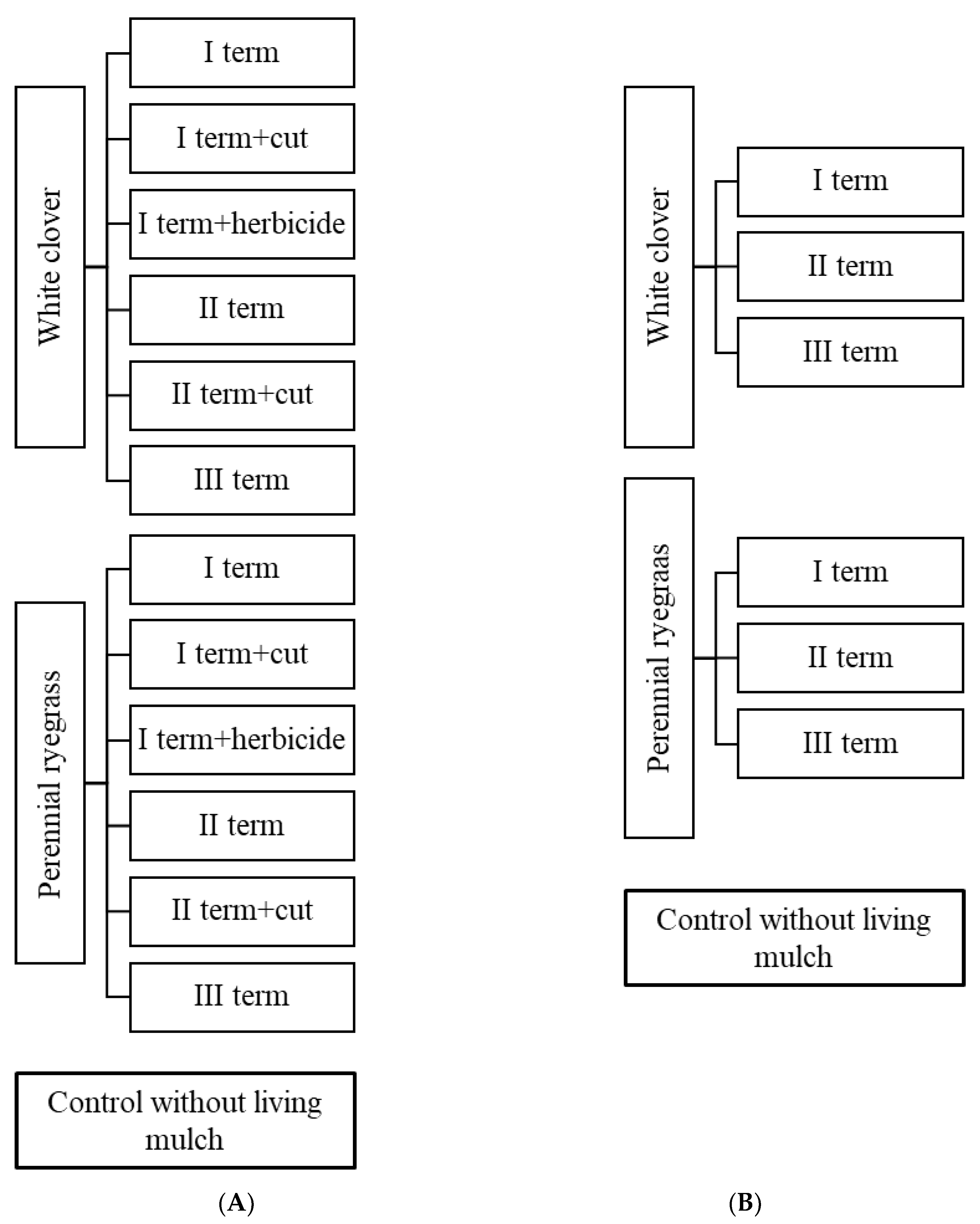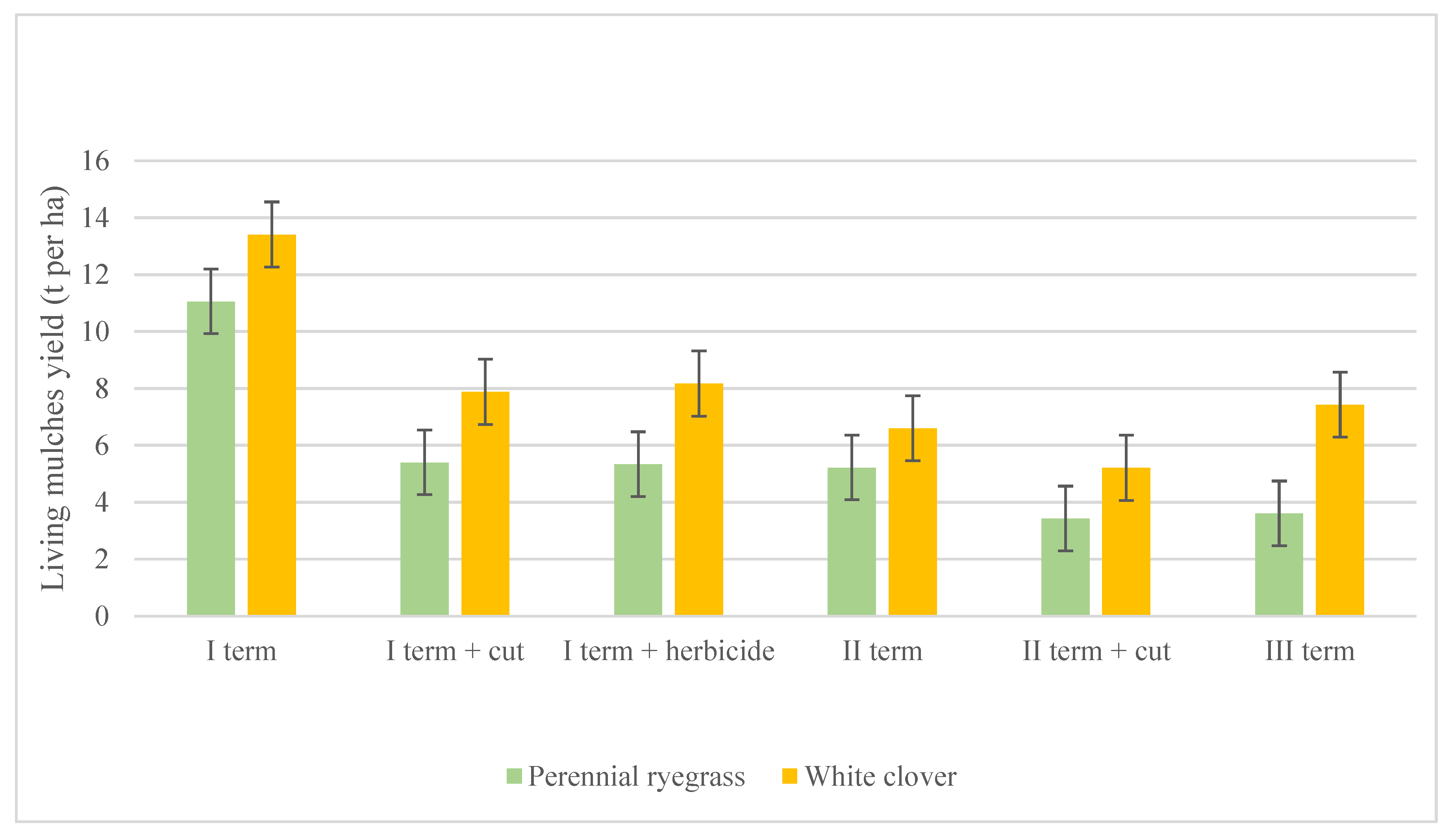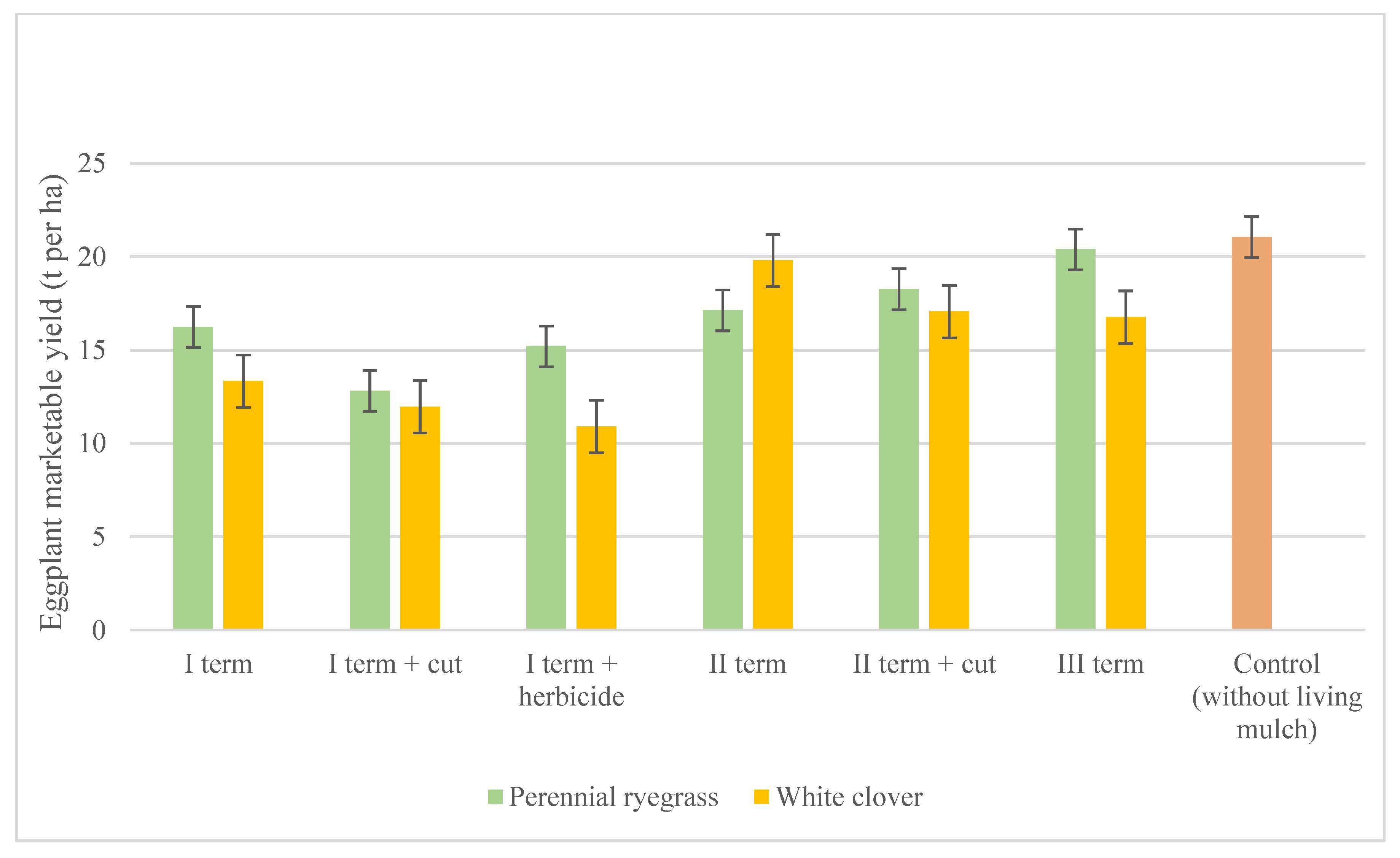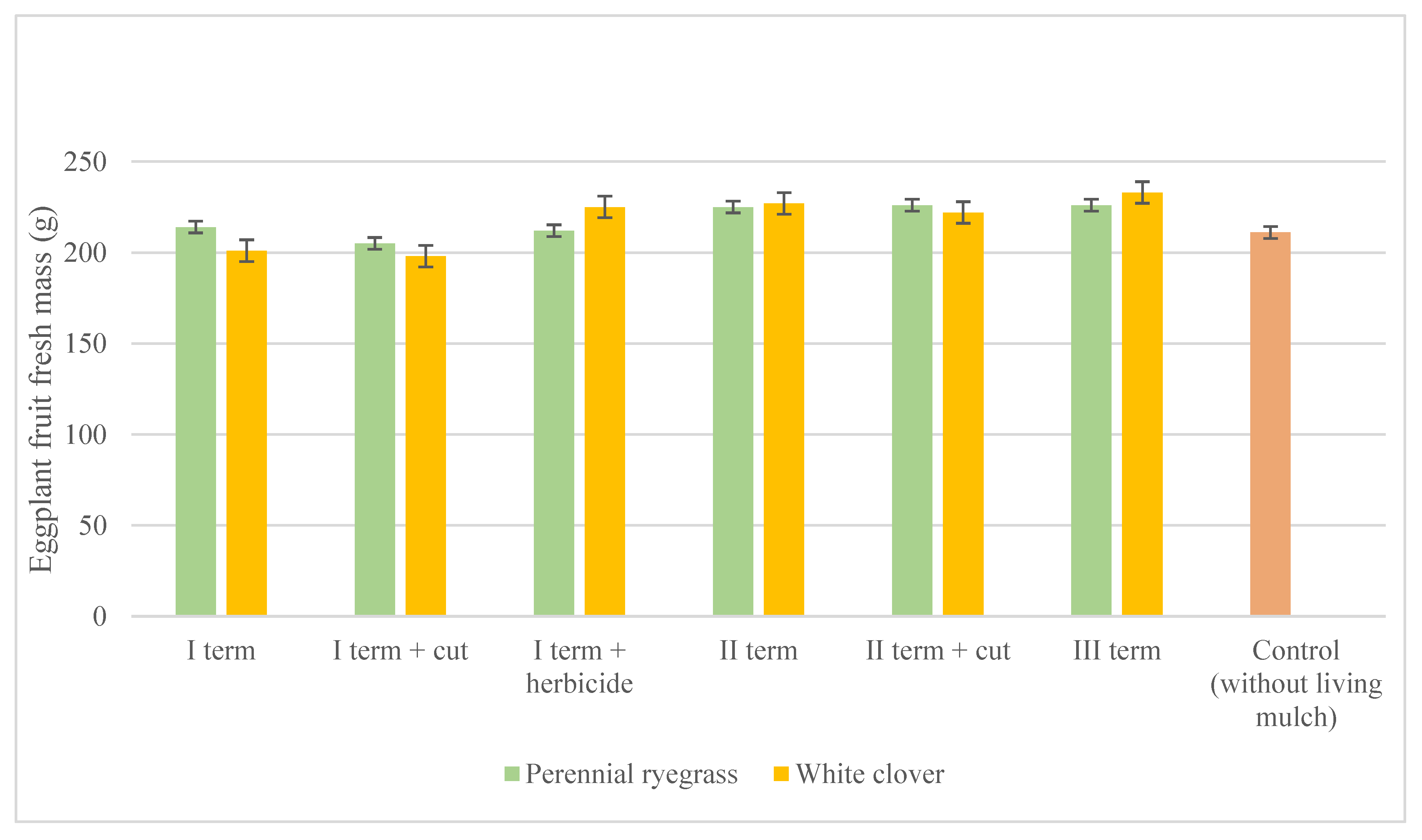Effect of Soil Regenerative Practice on Selected Soil Physical Properties and Eggplant (Solanum melongena L.) Yield
Abstract
:1. Introduction
2. Methods and Materials
2.1. Field Experiment Layout
2.2. Methods for Assesment of Soil Selected Physical Properties
- wia—weights of soil fraction i obtained using dry method;
- xia—value of soil fraction i obtained using dry method.
- wig—weights of soil fraction i obtained using wet method;
- xig—value of of soil fraction i obtained using wet method.
2.3. Statistical Analysis
3. Results and Discussion
4. Conclusions
Author Contributions
Funding
Institutional Review Board Statement
Informed Consent Statement
Data Availability Statement
Conflicts of Interest
References
- Bronick, C.J.; Lal, R. Soil structure and management: A review. Geoderma 2005, 124, 3–22. [Google Scholar] [CrossRef]
- Rabot, E.; Wiesmeier, M.; Schlüter, S.; Vogel, H.-J. Soil structure as an indicator of soil functions: A review. Geoderma 2018, 314, 122–137. [Google Scholar] [CrossRef]
- Johannesa, A.; Weisskopfa, P.; Schulinb, R.; Boivinc, P. Soil structure quality indicators and their limit values. Ecol. Indic. 2019, 104, 686–694. [Google Scholar] [CrossRef]
- Wander, M.A.; Walter, G.L.; Nissen, T.M.; Bollero, G.A.; Andrews, S.S.; Cavanough-Grant, D.A. Soil quality: Science and process. Agron. J. 2002, 94, 23–32. [Google Scholar] [CrossRef]
- Erkossa, T.; Itanna, F.; Stahr, K. Indexing soil quality: A new paradigm in soil science research. Aust. J. Soil Res. 2007, 45, 129–137. [Google Scholar] [CrossRef]
- Bastida, F.; Zsolnay, A.; Hernandez, T.; Garcia, C. Past, present and future of soil quality indices: A biological perspective. Geoderma 2008, 147, 159–171. [Google Scholar] [CrossRef]
- Reynolds, W.D.; Drury, C.F.; Yang, X.M.; Tan, C.S. Optimal soil physical quality inferred through structural regression and parameter interaction. Geoderma 2008, 146, 466–474. [Google Scholar] [CrossRef]
- Goutal, N.; Ranger, J.; Boivin, P. Assessment of the natural recovery rate of soil specific volume following forest soil compaction. Soil Sci. Soc. Am. J. 2012, 76, 1426–1435. [Google Scholar] [CrossRef]
- Newton, P.; Civita, N.; Frankel-Goldwater, L.; Bartel, K.; Johns, C. What Is Regenerative Agriculture? A Review of Scholar and Practitioner Definitions Based on Processes and Outcomes. Front. Sustain. Food Syst. 2020, 4, 577723. [Google Scholar] [CrossRef]
- Zanini, E.; Bonifacio, E.; Albertson, J.D.; Nielsen, D.R. Topsoil aggregate breakdown under water-saturated conditions. Soil Sci. 1998, 163, 288–298. [Google Scholar] [CrossRef]
- Boyd, N.S.; Gordon, R.; Asiedu, S.K.; Martin, R.C. The effect of living mulches on tuber yield of potato (Solanum tuberosum L.). Biol. Agric. Hortic. 2001, 18, 203–220. [Google Scholar] [CrossRef]
- Barthès, B.; Roose, E. Aggregate stability as an indicator of soil susceptibility to runoff and erosion; validation at several levels. Catena 2002, 47, 133–149. [Google Scholar] [CrossRef] [Green Version]
- Singh, M.J.; Khera, K.L. Physical indicators of soil quality in relation to soil erodibility under different land use. Arid. Land Res. Manag. 2009, 23, 152–167. [Google Scholar] [CrossRef]
- Blanco-Moure, N.; Moret-Fernández, D.; López, M.V. Dynamics of aggregate destabilization by water in soils under long-term conservation tillage in semiarid Spain. Catena 2012, 99, 34–41. [Google Scholar] [CrossRef] [Green Version]
- George, F.A.; Turley, E.; Mishra, B.; Heist, Q.; Upadhyaya, Y.; Trivette, T.; Nkuwi, L. Characterization of eggplant grown in animal manure amended soil. Int. J. Environ. Health Res. 2020, 30, 492–503. [Google Scholar] [CrossRef]
- Kołota, E.; Adamczewska-Sowińska, K. Living mulches in vegetable crops production: Perspectives and limitations (a reviev). Acta Sci. Pol. Hortorum Cultus 2013, 12, 127–142. [Google Scholar]
- Leary, J.K.; De Frank, J.; Sipes, B. Tropical eggplant (Solanum melongena L.) production with a buffelgrass (Pennisetum ciliare L.) living mulch system in Hawaii. Biol. Agric. Hortic. 2006, 24, 105–116. [Google Scholar] [CrossRef]
- Bhaskar, V.; Westbrook, A.S.; Bellinder, R.R.; DiTommaso, A. Integrated management of living mulches for weed control: A review. Weed Technol. 2021, 35, 856–868. [Google Scholar] [CrossRef]
- Depalo, L.; Burgio, G.; Von Fragstein, P.; Kristensen, H.; Bavec, M.; Robačer, M.; Canali, S. Impact of living mulch on arthropod fauna: Analysis of pest and beneficial dynamics on organic cauliflower (Brassica oleracea L. var. botrytis) in different European scenarios. Renew. Agric. Food Syst. 2017, 32, 240–247. [Google Scholar] [CrossRef]
- Iqbal, R.; Raza, M.A.S.; Valipour, M.; Saleem, M.F.; Zaheer, M.S.; Ahmad, S.; Toleikiene, M.; Haider, I.; Aslam, M.U.; Nazar, M.A. Potential agricultural and environmental benefits of mulches—A review. Bull. Natl. Res. Cent. 2020, 44, 75. [Google Scholar] [CrossRef]
- Tonitto, C.; David, M.B.; Drinkwater, L.E. Replacing bare fallows with cover crops in fertilizer-intensive cropping systems: A meta-analysis of crop yield and N dynamics. Agric. Ecosyst. Environ. 2006, 112, 58–72. [Google Scholar] [CrossRef]
- Kankanen, H.; Eriksson, C. Effects of undersown crops on soil mineral N and grain yield of spring barley. Eur. J. Agronomy 2007, 27, 25–34. [Google Scholar] [CrossRef]
- Sturite, I.; Henriksen, T.M.; Breland, T.A. Winter losses of nitrogen and phosphorus from Italian ryegrass, meadow fescue and white clover in a northern temperate climate. Agric. Ecosyst. Environ. 2007, 120, 280–290. [Google Scholar] [CrossRef]
- Sainju, U.M.; Singh, B.P.; Whitenhead, W.F. Long Term effects of tillage, cover crops and nitrogen fertilization on organic carbon and nitrogen concentrations in sandy loam soils in Georgia, USA. Soil Til. Res. 2002, 63, 167–179. [Google Scholar] [CrossRef]
- Thomsen, I.K.; Christensen, B.T. Yields of wheat and soil carbon and nitrogen contents following long-term incorporation of barley straw and ryegrass catch crops. Soil Use Manag. 2002, 20, 432–438. [Google Scholar] [CrossRef]
- Abdul-Baki, A.A.; Kotliński, S.; Kotlińska, T. Vegetable production systems. Veg. Crops Res. Bull. 2002, 57, 11–21. [Google Scholar]
- Lu, Y.-C.; Watkins, K.B.; Teasdale, J.R.; Abdul-Baki, A.A. Cover crops in sustainable food production. Food Rev. Int. 2000, 16, 121–157. [Google Scholar] [CrossRef]
- Ochsner, T.E.; Albrecht, K.A.; Schumacher, T.W.; Baker, J.M.; Berkevich, R.J. Water balance and nitrate leaching under corn kura clover living mulch. Agron. J. 2010, 1002, 1169–1178. [Google Scholar] [CrossRef]
- Rasse, D.P.; Smucker, A.J.M.; Santos, D. Alfalfa Root and Shoot Mulching Effects on Soil Hydraulic Properties and Aggregation. Soil Sci. Soc. Am. J. 2000, 64, 725–731. [Google Scholar] [CrossRef]
- Romaneckas, K.; Adamavičienė, A.; Šarauskis, E.; Kriaučiūnienė, Z.; Marks, M.; Vaitauskienė, K. Impact of living mulches on the physical properties of Planosol in monocropped maize cultivation. Int. Agrophysics 2018, 32, 165–173. [Google Scholar] [CrossRef]
- Chapman, M.A. Introduction: The Importance of Eggplant. In Compendium of Plant Genomes; Springer: Singapore, 2019; pp. 1–10. [Google Scholar]
- Frary, A.; Doganlar, S.; Daunay, M.C. Eggplant. In Vegetables SE-9, Genome Mapping and Molecular Breeding in Plants; Kole, C., Ed.; Springer: Berlin, Germany, 2007; pp. 287–313. [Google Scholar] [CrossRef]
- Taher, D.; Solberg, S.Ø.; Prohens, J.; Chou, Y.; Rakha, M.; Wu, T. World Vegetable Center Eggplant Collection: Origin, Composition, Seed Dissemination and Utilization in Breeding. Front. Plant Sci. 2017, 8, 1484. [Google Scholar] [CrossRef] [PubMed] [Green Version]
- Adamczewska-Sowińska, K.; Krygier, M.; Turczuk, J. The yield of eggplant depending on climate conditions and mulching. Folia Hortic. 2016, 28, 19–24. [Google Scholar] [CrossRef] [Green Version]
- Adamczewska-Sowińska, K.; Kołota, E. Yielding and nutritive value of field cultivated eggplant with the use of living and synthetic mulches. Acta Sci. Pol. Hortorum Cultus 2010, 9, 191–199. [Google Scholar]
- Adamczewska-Sowińska, K.; Sowiński, J. Reaction of Sweet Maize to the Use of Polyethylene Film and Polypropylene Non-Woven Fabric in the Initial Growth Phase. Agronomy 2020, 10, 141. [Google Scholar] [CrossRef] [Green Version]
- Antichi, D.; Sbrana, M.; Martelloni, L.; Abou Chehade, L.; Fontanelli, M.; Raffaelli, M.; Mazzoncini, M.; Peruzzi, A.; Frasconi, C. Agronomic performances of organic field vegetables managed with conservation agriculture techniques: A study from central Italy. Agronomy 2019, 9, 810. [Google Scholar] [CrossRef] [Green Version]
- Sportelli, M.; Frasconi, C.; Fontanelli, M.; Pirchio, M.; Gagliardi, L.; Raffaelli, M.; Peruzzi, A.; Antichi, D. Innovative Living Mulch Management Strategies for Organic Conservation Field Vegetables: Evaluation of Continuous Mowing, Flaming, and Tillage Performances. Agronomy 2022, 12, 622. [Google Scholar] [CrossRef]
- Pagliai, M.; Vignozzi, N.; Pellegrini, S. Soil structure and the effect of management practices. Soil Till. Res. 2004, 79, 131–143. [Google Scholar] [CrossRef]
- Hernanz, J.L.; Sanchez-Giron, V.; Navarrete, L. Soil carbon sequestration and stratification in a cereal/leguminous crop rotation with three tillage systems in semiarid conditions. Agric. Ecosyst. Environ. 2009, 133, 114–122. [Google Scholar] [CrossRef]
- Meza, K.; Vanek, S.J.; Sueldo, Y.; Olivera, E.; Ccanto, R.; Scurrah, M.; Fonte, S.J. Grass–Legume Mixtures Show Potential to Increase Above- and Belowground Biomass Production for Andean Forage-Based Fallows. Agronomy 2022, 12, 142. [Google Scholar] [CrossRef]
- Kęsik, T.; Błażewicz-Wożniak, M. Indicators of soil aggregation and their changes in conservation tillage for onion. Acta Sci. Pol. Hortorum Cultus 2010, 9, 73–85. [Google Scholar]
- Stagnari, F.; Maggio, A.; Galieni, A.; Pisante, M. Multiple benefits of legumes for agriculture sustainability: An overview. Chem. Biol. Technol. Agric. 2017, 4, 1–13. [Google Scholar] [CrossRef] [Green Version]
- Darboux, F.; Le Bissonnais, Y. Changes in structural stability with soil surface crusting: Con-sequences for erodibility estimation. Eur. J. Soil Sci. 2007, 58, 1107–1114. [Google Scholar] [CrossRef]
- Montague, T.; Kjelgren, R. Energy balance of six common landscape surfaces and the influence of surface properties on gas exchange of four containerized tree species. Sci. Hortic. 2004, 100, 229–249. [Google Scholar] [CrossRef]
- Chalker-Scott, L. Impact of mulches on landscape plants and the environment—A review. J. Environ. Hortic. 2007, 25, 239–249. [Google Scholar] [CrossRef]
- Álvaro-Fuentes, J.; Arrúe, J.L.; Gracia, R.; López, M.V. Tillage and cropping intensification effects on soil aggregation: Temporal dynamics and controlling factors under semiarid conditions. Geoderma 2008, 145, 390–396. [Google Scholar] [CrossRef] [Green Version]
- White, R.E. Principles and Practice of Soil Science, 4th ed.; Blackwell Publishing: Oxford, UK, 2006. [Google Scholar]
- Gajda, A.M.; Czyż, E.A.; Ukalska-Jaruga, A. Comparison of the Effects of Different Crop Production Systems on Soil Physico-Chemical Properties and Microbial Activity under Winter Wheat. Agronomy 2020, 10, 1130. [Google Scholar] [CrossRef]
- Janušauskaite, D.; Kadžienė, G.; Auškalnienė, O. The Effect of Tillage System on Soil Microbiota in Relation to Soil Structure. Pol. J. Environ. Stud. 2013, 22, 1387–1391. [Google Scholar]
- Borowy, A. Growth and yield of stake tomato under no-tillage cultivation using hairy vetch as a living mulch. Acta Sci. Pol. Hortorum Cultus 2012, 11, 229–252. [Google Scholar]




| Months | 2010 | 2011 | 2012 | |||
|---|---|---|---|---|---|---|
| Mean | Deviation * | Mean | Deviation * | Mean | Deviation * | |
| Temperature (°C) | ||||||
| May | 13.3 | −0.2 | 14.9 | 1.4 | 15.9 | 2.4 |
| June | 17.5 | 1.2 | 19.1 | 2.8 | 17.2 | 0.9 |
| July | 21.0 | 2.9 | 18.2 | 0.1 | 20.1 | 2.0 |
| August | 18.8 | 1.0 | 19.4 | 1.6 | 19.7 | 1.9 |
| September | 12.5 | −1.1 | 15.9 | 2.3 | 14.8 | 1.2 |
| Rainfall (mm) | ||||||
| May | 134.5 | 77.5 | 41.4 | −15.6 | 20.5 | −36.5 |
| June | 24.8 | −54.2 | 21.9 | −57.1 | 77.1 | −1.9 |
| July | 79.1 | −11.9 | 153.2 | 62.2 | 70.8 | −20.2 |
| August | 74.0 | 10.0 | 22.7 | −41.3 | 48.4 | −15.6 |
| September | 88.8 | 37.8 | 21.8 | −29.2 | 45.0 | −6.0 |
| Type and Sowing Term of Living Mulch | B | W | MWDa |
|---|---|---|---|
| white clover I term | 0.35 | 1.59 | 3.08 |
| white clover II term | 0.38 | 1.52 | 3.08 |
| white clover III term | 0.39 | 1.49 | 2.98 |
| mean | 0.37 | 1.53 b | 3.04 |
| perennial ryegrass I term | 0.29 | 1.67 | 2.74 |
| perennial ryegrass II term | 0.32 | 1.60 | 3.13 |
| perennial ryegrass III term | 0.37 | 1.23 | 2.97 |
| mean | 0.33 | 1.50 b | 2.95 |
| mean for sowing term I term | 0.32 | 1.63 | 2.91 |
| II term | 0.35 | 1.56 | 3.10 |
| III term | 0.38 | 1.36 | 2.98 |
| Control without living mulch | 0.50 | 1.17 a | 2.77 |
| LSDα = 0.05 for: | |||
| type of living mulch | n.s. | n.s. | n.s. |
| sowing term of living mulch | n.s. | n.s, | n.s. |
| cultivation method | n.s. | * | n.s. |
| Type and Sowing Term of Living Mulch | MWDg (mm) | ΔMWD | Wod |
|---|---|---|---|
| white clover I term | 1.18 | 2.29 | 31.5 |
| white clover II term | 1.19 | 2.23 | 27.9 |
| white clover III term | 1.06 | 2.06 | 27.3 |
| mean | 1.14 b | 2.19 b | 28.9 b |
| perennial ryegrass I term | 1.22 | 2.30 | 32.9 |
| perennial ryegrass II term | 1.09 | 2.29 | 30.7 |
| perennial ryegrass III term | 1.09 | 2.11 | 28.3 |
| mean | 1.13 b | 2.23 b | 30.6 b |
| mean for sowing term I term | 1.20 | 2.30 | 32.2 |
| II term | 1.14 | 2.26 | 29.3 |
| III term | 1.07 | 2.08 | 27.8 |
| Control without living mulch | 0.96 a | 1.71 a | 26.8 a |
| LSDα = 0.05 for: | |||
| type of living mulch | n.s. | n.s. | n.s. |
| sowing term of living mulch | n.s. | n.s. | n.s. |
| cultivation method | * | * | * |
| Type and Sowing Term of Living Mulch | Soil Moisture | Total Porosity | Capillary Porosity | |||
|---|---|---|---|---|---|---|
| Soil Layer (cm) | ||||||
| 5–10 | 15–20 | 5–10 | 15–20 | 5–10 | 15–20 | |
| white clover I term | 18.8 | 18.6 | 40.4 | 41.0 | 31.2 | 32.5 |
| white clover II term | 18.8 | 18.7 | 41.3 | 40.7 | 31.2 | 32.1 |
| white clover III term | 19.0 | 19.0 | 39.9 | 40.5 | 31.6 | 33.6 |
| mean | 18.9 | 18.8 | 40.5 b | 40.7 | 31.3 b | 32.7 b |
| perennial ryegrass I term | 18.1 | 18.8 | 41.0 | 41.1 | 31.9 | 33.0 |
| perennial ryegrass II term | 18.5 | 18.7 | 40.0 | 40.0 | 31.2 | 32.4 |
| perennial ryegrass III term | 19.0 | 19.1 | 40.4 | 39.7 | 31.5 | 32.2 |
| mean | 18.5 | 18.9 | 40.5 b | 40.3 | 31.5 b | 32.5 b |
| mean for sowing term I term | 18.5 | 18.7 | 40.7 | 41.1 | 31.5 | 32.8 |
| II term | 18.6 | 18.7 | 40.5 | 40.4 | 31.2 | 32.2 |
| III term | 19.0 | 19.0 | 40.1 | 40.1 | 31.5 | 32.9 |
| Control without living mulch | 17.7 | 19.1 | 38.9 a | 39.1 | 29.3 a | 30.2 a |
| LSDα = 0.05 for: | ||||||
| type of living mulch | n.s. | n.s. | n.s. | n.s. | n.s. | n.s. |
| sowing term of living mulch | n.s. | n.s. | n.s. | n.s. | n.s. | n.s. |
| cultivation method | n.s. | n.s. | ** | n.s. | ** | ** |
| Type and Sowing Term of Living Mulch | Bulk Density | Soil Compaction | ||
|---|---|---|---|---|
| Soil Layer (cm) | ||||
| 5–10 | 15–20 | 0–10 | 10–20 | |
| white clover I term | 1.58 | 1.59 | 2.74 | 4.86 |
| white clover II term | 1.59 | 1.62 | 2.96 | 5.25 |
| white clover III term | 1.66 | 1.62 | 3.27 | 6.11 |
| mean | 1.61 a | 1.61 a | 2.99 b | 5.41 b |
| perennial ryegrass I term | 1.58 | 1.61 | 2.51 | 4.29 |
| perennial ryegrass II term | 1.61 | 1.60 | 2.50 | 5.01 |
| perennial ryegrass III term | 1.63 | 1.61 | 2.84 | 4.99 |
| mean | 1.61 a | 1.61 a | 2.62 a | 4.77 a |
| mean for sowing term I term | 1.58I | 1.60 | 2.63 | 4.58 a |
| II term | 1.60I | 1.61 | 2.73 | 5.13 ab |
| III term | 1.65II | 1.62 | 3.05 | 5.55 b |
| Control without living mulch | 1.64 b | 1.66 b | 3.09 | 5.31 |
| LSDα = 0.05 for: | ||||
| type of living mulch | n.s. | n.s. | * | ** |
| sowing term of living mulch | *** | n.s. | n.s. | ** |
| cultivation method | * | ** | n.s. | n.s. |
Publisher’s Note: MDPI stays neutral with regard to jurisdictional claims in published maps and institutional affiliations. |
© 2022 by the authors. Licensee MDPI, Basel, Switzerland. This article is an open access article distributed under the terms and conditions of the Creative Commons Attribution (CC BY) license (https://creativecommons.org/licenses/by/4.0/).
Share and Cite
Adamczewska-Sowińska, K.; Wojciechowski, W.; Krygier, M.; Sowiński, J. Effect of Soil Regenerative Practice on Selected Soil Physical Properties and Eggplant (Solanum melongena L.) Yield. Agronomy 2022, 12, 1686. https://doi.org/10.3390/agronomy12071686
Adamczewska-Sowińska K, Wojciechowski W, Krygier M, Sowiński J. Effect of Soil Regenerative Practice on Selected Soil Physical Properties and Eggplant (Solanum melongena L.) Yield. Agronomy. 2022; 12(7):1686. https://doi.org/10.3390/agronomy12071686
Chicago/Turabian StyleAdamczewska-Sowińska, Katarzyna, Wiesław Wojciechowski, Magdalena Krygier, and Józef Sowiński. 2022. "Effect of Soil Regenerative Practice on Selected Soil Physical Properties and Eggplant (Solanum melongena L.) Yield" Agronomy 12, no. 7: 1686. https://doi.org/10.3390/agronomy12071686
APA StyleAdamczewska-Sowińska, K., Wojciechowski, W., Krygier, M., & Sowiński, J. (2022). Effect of Soil Regenerative Practice on Selected Soil Physical Properties and Eggplant (Solanum melongena L.) Yield. Agronomy, 12(7), 1686. https://doi.org/10.3390/agronomy12071686





